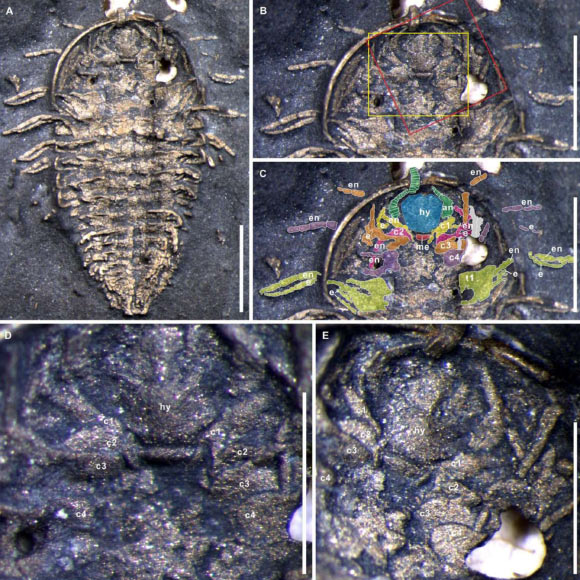
Based on multiple analytical techniques applied to well-preserved soft-bodied specimens of two trilobite species, the Late Ordovician species Triarthrus eatoni and the Middle Cambrian species Olenoides serratus, paleontologists argue that an additional pair of cephalic appendages occurred just behind the antennae, indicating that trilobites had five pairs of cephalic appendages and six segments.
Trilobites are extinct arthropods that dominated the faunas of the oceans of the Paleozoic era.
During their time on Earth, which lasted much longer than the dinosaurs, they survived two major episodes of mass extinctions and dominated ocean floor ecosystems.
They appeared in ancient oceans in the Early Cambrian, about 540 million years ago — well before life emerged on land, and disappeared in the mass extinction at the end of the Permian, about 252 million years ago.
They were extremely diverse, with about 20,000 species, and their fossil exoskeletons can be found all around the world.
Like other arthropods, the bodies of trilobites are made up of many segments, with the head region comprised of several fused segments.
As with other parts of the trilobite body (thorax and tail), these segments were associated with appendages, which ranged in function from sensing to feeding to locomotion.
“The number of these segments and how they are associated with other important traits, like eyes and legs, is important for understanding how arthropods are related to one another, and therefore, how they evolved,” said Dr. Melanie Hopkins, curator and chair of the Division of Paleontology at the American Museum of Natural History.
The segments in the trilobite head can be counted in two different ways: by looking at the grooves (called furrows) on the upper side of the trilobite fossil’s hard exoskeleton, or by counting the pairs of preserved antennae and legs on the underside of the fossil.
The soft appendages of trilobites are rarely preserved, though, and when looking at the segments in the trilobite head, researchers regularly find a mismatch between these two methods.
In the new study, Dr. Hopkins and Nanjing University’s Dr. Jin-Bo Hou examined new specimens of Triarthrus eatoni.
These fossils, known for the gold shine of the pyrite replacement preserving them, show an additional, previously undescribed leg underneath the head.
“This fantastic preservation style allows us to observe 3D appendages in hundreds of specimens directly from the ventral side of the animals, just like looking at the appendages of horseshoe crabs on a beach by grabbing them and turning them upside down,” Dr. Hou said.
By making comparisons with another trilobite species, the exceptionally preserved Olenoides serratus from the Burgess Shale in British Columbia, the authors propose a model for how appendages were attached to the head in relation to the grooves in the exoskeleton.
“This model resolves the apparent mismatch and indicates that the trilobite head included six segments: an anterior segment associated with the developmental origin of the eyes and five additional segments, associated with one pair of antennae and four pairs of walking legs, respectively,” they explained.
Their paper was published today in the journal Palaeontology.
_____
Jin-bo Hou & Melanie J. Hopkins. 2024. New evidence for five cephalic appendages in trilobites and implications for segmentation of the trilobite head. Palaeontology 67 (5): e12723; doi: 10.1111/pala.12723
 Print
Print



